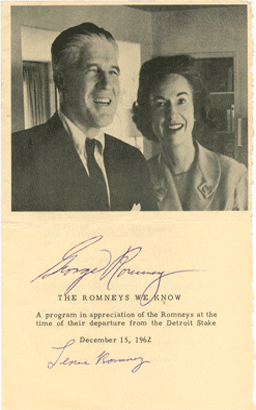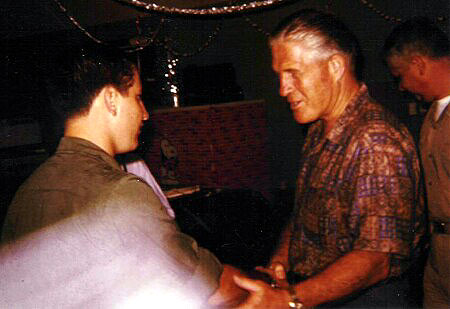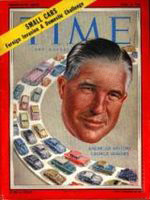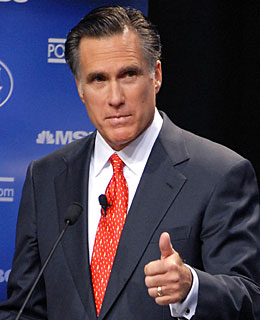|
IIGEORGE WILCKEN ROMNEY 1907-1995 -Governor of Michigan
|
Website Link Index | ||||||||||||||||||||||
|
Orson Pratt Brown's wife Martha Diana Romney's Half-Brother's Son |
|||||||||||||||||||||||
George Wilcken RomneyBorn: July 8, 1907 at Colonia Dublán, Chihuahua, Mexico
**George W. Romney - President of American Motors
****George W. Romney, 1907-1995
|
|||||||||||||||||||
| George Romney, whose leadership saved AMC from the brink of collapse in the late 50's, died on July 26, 1995. It was Romney who made the difficult decision in 1957 to drop the Nash and Hudson brands -- two of the oldest marques in the business, and the company's legacy -- to concentrate exclusively on the compact Rambler line. It turned out to be a brilliant stroke: AMC's sales quadrupled in two years, and Rambler passed Plymouth to become the third best-selling make in the U.S. Some AMC historians believe that if the company had not abandoned Romney's strategy of concentrating on a single compact platform (an approach that worked spectacularly for Volkswagen in the 60's) it might still be around today. |

**December 15, 1962 Farewell Program for Livonia Stake President George W. Romney and his wife Lenore
as they take on new positions as Governor and First Lady of Michigan.
 |
FAREWELL TO GEORGE AND LENORE
From the Livonia, Michigan Stake
George W. Romney was the Detroit, Michigan Stake President. In this role he was the spiritual and administrative leader of 3,600 members in eastern Michican, western Ontario and northern Ohio. The Detroit Stake building on Woodward Avenue was the first Stake building east of the Mississippi River since the Mormon exodus in 1846 from Nauvoo, Illinois. |

Governor George W. Romney, December 1967 in Vietnam
| Governor George W. Romney is shaking Doc Rocketts hand at NSA Station Hospital, Danang, Viet Nam. The Navy officer behind Governor Romney is the Commanding Officer of NSA Station Hospital during December 1967. At this point Romney was the Republican front runner candidate for President of the United States. In 1968, after his return from Viet Nam, Romney declined the nomination stating that he now felt he had been brainwashed by the generals. |

.... George W. Romney - Secretary of H.U.D. under President Richard M. Nixon
![]()
1
Margo Lynn RomneyBorn: 6 June 1935 in Washington D.C. Married: Keenan Died:
|
2
Jane LaFont RomneyBorn: 18 March 1938 in Washington D.C. Married: Robinson Died:
|
3
George Scott RomneyBorn: 7 June 1941 in Detroit, Wayne, Michigan Married: Died:
|
4
Willard Mitt RomneyBorn: 12 March 1947 in Detroit, Wayne, Michigan Married: Ann Davies Died:
|

| Willard Mitt Romney is an American Republican politician from Massachusetts. The son of former Michigan Governor George W. Romney, Mitt Romney received his B.A. from Brigham Young University in 1971, then an M.B.A. and J.D. from Harvard University in 1975. Mitt Romney is a successful businessman and the 1994 Republican U.S. Senate nominee, running against Senator Ted Kennedy, losing 58% - 41%, the closest election of Kennedy's long Senate career. Mitt Romney was the Chairman of the Winter Olympics XXIX held in Utah in 2002. Mitt and his wife, Ann Davies Romney, his high school sweetheart, own a home in Deer Valley, Utah. Mitt was elected Governor of Massachusetts in 2003. |
|
|
PAF - Archer files = Orson Pratt Brown + (1) Martha Diana Romney < Miles Park Romney + (1) Hannah Hood Romney 1842-1928 (Martha's mother is (2) Caroline Lambourne) > Gaskill Romney 1871-1955 + (1) Anna Amelia Pratt 1876-1926 > George Wilcken Romney 1907-1995 Governor of Michigan + Lenore Emily LaFount 1908-1998 > Mitt Romney 1947- Chairman of the XXIX Winter Olympics held in Utah in 2002 and is now the Governor of Massachusetts.
Lucy Brown Archer Book of Remembrance - George Romney was Stake President of Lucy's Stake in Michigan. Lucy was a member of Young Republicans in Jr. High and High School and worked on two of George Romney's campaigns. In between sessions of Stake Conference, Lucy and Mitt and other teens would gather under the trees of the Conference Center to eat box lunches provided by the Relief Society. Mitt and Lucy attended BYU during the same years. Then later, Mitt Romney bought a house around 1997 in Deer Valley/ Park City where Lucy has lived since 1982. Both worked on the XXIX Winter Olympics, Mitt as Chairman of the whole shabang, Lucy as a lowly SLOC (Salt Lake Olympic Committee) Volunteer and Park City Olympic Media Center representative.
Photos from Inauguration Invitation and Livonia Michigan Stake Farewell Program, The Detroit Free Press, and other sources saved in Lucy's Book of Remembrance.
Copyright 2001 www.orsonpratt brown.com
![]()
To SEARCH THIS SITE: Use the Google.com search engine
Type....site:OrsonPrattBrown.org "TYPE NAME YOU ARE
LOOKING FOR INSIDE PARENTHESIS"...Press ENTER
A list with the search term will appear.
![]() OPB FAMILY BLOG SITE
OPB FAMILY BLOG SITE
... http://orsonprattbrownfamily.blogspot.com/
![]() PERSONAL ANCESTRAL FILE
PERSONAL ANCESTRAL FILE
... Password Access Only
![]() ADDRESS LIST FOR BROWN FAMILY
ADDRESS LIST FOR BROWN FAMILY
... Password Access Only
![]() ORSON PRATT BROWN FAMILY REUNIONS
ORSON PRATT BROWN FAMILY REUNIONS
... Easter 1986 through October 2005
... ARTICLES OF ASSOCIATION - BY-LAWS
COMMENTS AND INPUT ON ARTICLES
... Published December 2007:
![]() "ORSON PRATT BROWN AND HIS FIVE WONDERFUL WIVES VOL. I and II"
"ORSON PRATT BROWN AND HIS FIVE WONDERFUL WIVES VOL. I and II"
![]() By Erold C. Wiscombe
By Erold C. Wiscombe
... Published March 2009:
![]() "CAPTAIN JAMES BROWN AND HIS 13 WIVES"
"CAPTAIN JAMES BROWN AND HIS 13 WIVES"
(unfortunately the publisher incorrectly changed the photo
and spelling of Phebe Abbott Brown Fife's name
after it was proofed by this author)
Researched and Compiled by Erold C. Wiscombe
... Published 2012:
"Finding Refuge in El Paso"
By Fred E. Woods [ISBN: 978-1-4621-1153-4]
Includes O.P Brown's activities as Special Church Agent in El Paso
and the Juarez Stake Relief Committee Minutes of 1912.
...Published 2012:
"Colonia Morelos: Un ejemplo de ética mormona
junto al río Bavispe (1900-1912)"
By Irene Ríos Figueroa [ISBN: 978-607-7775-27-0]
Includes O.P. Brown's works as Bishop of Morelos. Written in Spanish.
...Published 2014:
"The Diaries of Anthony W. Ivins 1875 - 1932"
By Elizabeth Oberdick Anderson [ISBN: 978-156085-226-1]
Mentions O.P. Brown more than 30 times as Ivins' companion.
... To be Published Soon:
![]() "CAPTAIN JAMES BROWN 1801-1863:
"CAPTAIN JAMES BROWN 1801-1863:
![]() TEMPER BY NATURE, TEMPERED BY FAITH"
TEMPER BY NATURE, TEMPERED BY FAITH"
![]() Send Comments and Information to:
Send Comments and Information to:
![]() OrsonPrattBrown@gmail.com
OrsonPrattBrown@gmail.com
... FAMILY GROUP PHOTOS
... FAMILY REUNIONS
... Lily Gonzalez Brown 80th Birthday Party-Reunion
![]() July 14, 2007 in American Fork, Utah
July 14, 2007 in American Fork, Utah
...Gustavo Brown Family Reunion in October 2007
... FAMILY MEMBERS WHO DIED RECENTLY
... NEWS, WEDDINGS, BABIES, MORE
... HELP US IDENTIFY THESE ANCESTORS
![]() Send Additions and Information to:
Send Additions and Information to:
![]() OrsonPrattBrown@gmail.com
OrsonPrattBrown@gmail.com
...... Wives and 35 Children Photo Chart
...... Chronology
...... Photo Gallery of OPB
...... Letters
...... Biographical Sketch of the Life Orson Pratt Brown
...... History of Orson Pratt Brown by Orson P. Brown
...... Journal & Reminiscences of Capt. Orson P. Brown
...... Memories of Orson P. Brown by C. Weiler Brown
...... Orson Pratt Brown by "Hattie" Critchlow Jensen
...... Orson Pratt Brown by Nelle Spilsbury Hatch
...... Orson Pratt Brown by W. Ayrd Macdonald
...... Wives and 29 / 43 Children Photo Chart
...... Captain James Brown's Letters & Journal
...... Brown Family Memorabilia
...... Mormon Battalion 1846-1847
...... Brown's Fort ~ then Brownsville, Utah
...... Chronology of Captain James Brown
- James Brown of Rowan County, N.C. 1757-1823
- Mary Williams of Rowan County, N.C. 1760-1832
- Stephen Joseph Abbott of, PA 1804-1843
- Abigail Smith of Williamson, N.Y. 1806-1889
- John Fife of Tulliallan, Scotland 1807-1874
- Mary Meek Nicol, Carseridge, Scotland 1809-1850
- Martha "Mattie" Diana Romney Brown 1870-1943
![]()
![]()
![]()
- Jane "Jennie" Bodily Galbraith Brown 1879-1944
![]()
![]()
- Elizabeth Graham MacDonald Webb Brown 1874-1904
- Eliza Skousen Brown Abbott Burk 1882-1958
- Angela Maria Gavaldón Brown 1919-1967
![]()
- (Martha) Carrie Brown (child) 1888-1890
- (Martha) Orson Pratt Brown, Jr. (child) 1890-1892
- (Martha) Ray Romney Brown 1892-1945
- (Martha) Clyde Romney Brown 1893-1948
- (Martha) Miles Romney Brown 1897-1974
- (Martha) Dewey B. Brown 1898-1954
- (Martha) Vera Brown Foster Liddell Ray 1901-1975
- (Martha) Anthony Morelos Brown 1904-1970
- (Martha) Phoebe Brown Chido Gardiner 1906-1973
- (Martha) Orson Juarez Brown 1908-1981
- (Jane) Ronald Galbraith Brown 1898-1969
- (Jane) Grant "Duke" Galbraith Brown 1899-1992
- (Jane) Martha Elizabeth Brown Leach Moore 1901-1972
- (Jane) Pratt Orson Galbraith Brown 1905-1960
- (Jane) William Galbraith Brown (child) 1905-1912
- (Jane) Thomas Patrick Porfirio Diaz Brown 1907-1978
- (Jane) Emma Jean Galbraith Brown Hamilton 1909-1980
- (Elizabeth) (New born female) Webb 1893-1893
- (Elizabeth) Elizabeth Webb Brown Jones 1895-1982
- (Elizabeth) Marguerite Webb Brown Shill 1897-1991
- (Elizabeth) Donald MacDonald Brown 1902-1971
- (Elizabeth) James Duncan Brown 1904-1943
- (Eliza) Gwen Skousen Brown Erickson Klein 1903-1991
- (Eliza) Anna Skousen Brown Petrie Encke 1905-2001
- (Eliza) Otis Pratt Skousen Brown 1907-1987
- (Eliza) Orson Erastus Skousen Brown (infant) 1909-1910
- (Eliza) Francisco Madera Skousen Brown 1911-1912
- (Eliza) Elizabeth Skousen Brown Howell 1914-1999
- (Angela) Silvestre Gustavo Brown 1919-
- (Angela) Bertha Erma Elizabeth Brown 1922-1979
- (Angela) Pauly Gabaldón Brown 1924-1998
- (Angela) Aaron Aron Saul Brown 1925
- (Angela) Mary Angela Brown Hayden Green 1927
- (Angela) Heber Jedediah Brown (infant) 1936-1936
- (Angela) Martha Gabaldón Brown Gardner 1940
- Stephen Abbott Brown 1851-1853
- Phoebe Adelaide Brown Snyder 1855-1930
- Cynthia Abigail Fife Layton 1867-1943
- (New born female) Fife 1870-1870
- (Toddler female) Fife 1871-1872
- (Martha Stephens) John Martin Brown 1824-1888
- (Martha Stephens) Alexander Brown 1826-1910
- (Martha Stephens) Jesse Stowell Brown 1828-1905
- (Martha Stephens) Nancy Brown Davis Sanford 1830-1895
- (Martha Stephens) Daniel Brown 1832-1864
- (Martha Stephens) James Moorhead Brown 1834-1924
- (Martha Stephens) William Brown 1836-1904
- (Martha Stephens) Benjamin Franklin Brown 1838-1863
- (Martha Stephens) Moroni Brown 1838-1916
- (Susan Foutz) Alma Foutz Brown (infant) 1842-1842
- (Esther Jones) August Brown (infant) 1843-1843
- (Esther Jones) Augusta Brown (infant) 1843-1843
- (Esther Jones) Amasa Lyman Brown (infant) 1845-1845
- (Esther Jones) Alice D. Brown Leech 1846-1865
- (Esther Jones) Esther Ellen Brown Dee 1849-1893
- (Sarah Steadwell) James Harvey Brown 1846-1912
- (Mary McRee) George David Black 1841-1913
- (Mary McRee) Mary Eliza Brown Critchlow1847-1903
- (Mary McRee) Margaret Brown 1849-1855
- (Mary McRee) Mary Brown Edwards Leonard 1852-1930
- (Mary McRee) Joseph Smith Brown 1856-1903
- (Mary McRee) Josephine Vilate Brown Newman 1858-1917
- (Phebe Abbott) Stephen Abbott Brown (child) 1851-1853
- (Phebe Abbott) Phoebe Adelaide Brown 1855-1930
- (Cecelia Cornu) Charles David Brown 1856-1926
- (Cecelia Cornu) James Fredrick Brown 1859-1923
- (Lavinia Mitchell) Sarah Brown c. 1857-
- (Lavinia Mitchell) Augustus Hezekiah Brown c. 1859
- (Diane Davis) Sarah Jane Fife White 1855-1932
- (Diane Davis) William Wilson Fife 1857-1897
- (Diane Davis) Diana Fife Farr 1859-1904
- (Diane Davis) John Daniel Fife 1863-1944
- (Diane Davis) Walter Thompson Fife 1866-1827
- (Diane Davis) Agnes Ann "Aggie" Fife 1869-1891
- (Diane Davis ) Emma Fife (child) 1871-1874
- (Diane Davis) Robert Nicol Fife (infant) 1873-1874
- (Diane Davis) Barnard Fife (infant) 1881-1881
- (Cynthia Abbott) Mary Lucina Fife Hutchins 1868-1950
- (Cynthia Abbott) Child Fife (infant) 1869-1869
- (Cynthia Abbott) David Nicol Fife 1871-1924
- (Cynthia Abbott) Joseph Stephen Fife (child) 1873-1878
- (Cynthia Abbott) James Abbott Fife (infant) 1877-1878
- (Diana) Caroline Lambourne 18461979
- (Diana) Miles Park Romney 1843-1904
- (Jane) Emma Sarah Bodily 1858-1935
- (Jane) William Wilkie Galbraith 1838-1898
- (Elizabeth) Alexander F. Macdonald 1825-1903
- (Elizabeth) Elizabeth Atkinson 1841-1922
- (Eliza) Anne Kirstine Hansen 1845-1916
- (Eliza) James Niels Skousen 1828-1912
- (Angela) Maria Durán de Holguin 1876-1955
- (Angela) José Tomás Gabaldón 1874-1915
|
Contact Us: |